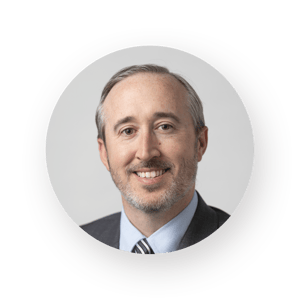November 2023
Leadership Elite
Table of Contents

The Value of Two-Way Communication
Thank you to everyone who joined us in Wisconsin for the annual Leadership Elite meeting. The event offered the first opportunity for the best of ProAssurance's agents and brokers to meet face-to-face with our team to discuss key trends in the medical liability industry. We are already putting together plans for next year’s event based on your feedback and the successes throughout the meeting.
The 2023 event included two days packed full of Company information and industry updates—plus plenty of social time to ask questions and grab a few sidebar conversations. We have gathered the highlights from the main room sessions in this issue, both to inform those who were not present at the meeting and as a reference for our attendees.
Our top priority is providing you with the information you need to successfully sell insurance; this is a foundational piece of our efforts to become your Carrier of Choice. If there is anything we can do to improve our communications—or something in particular you think we should be covering to keep you in the loop day to day—please let us know. You can always email content suggestions or questions to AskMarketing@ProAssurance.com.
A Word from Mike Rosenthal
From your feedback throughout the year, we have identified four key areas of focus:
- Responsiveness: We must be prompt and consistent.
- Overall flexibility: Underwriting needs to be open to conversation on sales possibilities.
- Expertise: Two-thirds of our Elite group has been in the business since the last hard market. We must take advantage of their expertise as part of our decision-making process.
- Innovation: We will continue to explore new programs and options that will help us gain profitable business.
We are currently experiencing the longest soft market in history, with companies using their surplus and capital to suppress pricing. However, we are starting to see the indicators that the market is adjusting.
ProAssurance spent several years re-underwriting our book of business and are now seeing the fruits of those labors. Not only did we survive, but we thrived.
We are a nationwide carrier, and when you operate in 50 states, you have 50 different lines of business. We have been in these markets for years. We know the claims environment, the laws, and the nuances of the market in each state. The carriers breaking into new markets lack that depth.
We are going back to a time with high ratios, where companies must fight to survive. The last hard market ended with a stroke of luck; frequency fell off and our industry was saved.
As the stakes get higher, the need for expertise gets greater. Mid-tier companies shrank by nearly 25% while gaining 13% market share last year.* They are playing a short-term game with serious long-term consequences. ProAssurance is well-positioned for the future. Our agency partners have the experience to recognize the difference in quality between mid- and top-tier carriers, and can help navigate their clients to a more sustainable choice.
*Ranking data from the S&P Global Market Share Application, which provided 2022 NAIC filings for all medical professional liability lines as of 9/28/2023.

A Call to Change the Narrative
Presented by Ned Rand
ProAssurance operates squarely within two industries—healthcare and insurance—that are grappling with significant public relations challenges. On the healthcare side, trust in the medical community has fallen from historical levels. Lack of trust carries all sorts of negative consequences, tending to increase the inclination of patients to sue doctors, hospitals, and other healthcare providers while simultaneously making juries more skeptical of evidence presented in defense of the care rendered—and thus more likely to find malpractice liability and award damages.
Is Insurance More than a Necessary Evil?
While negative perception of the healthcare industry increases the risk we assume on behalf of our insureds, public opinion of the insurance industry is perhaps even worse. Frequently when consumers hear the word "insurance" they think of health insurance (and frustrations with securing coverage for medical procedures or pharmaceuticals may well exacerbate negative feelings about the entire healthcare system). They may also think of automobile coverage that they are legally required to buy from carriers that may or may not provide the best experience when handling claims.
What people generally don’t think about when considering the insurance industry is the immeasurable seriousness of what we do. Simply put, without insurance carriers and their distribution partners who provide mechanisms for pooling of financial risk, all commerce would grind to a halt. No single business can possibly bear the full financial risk associated with a catastrophic loss of property or liability claims with values that in some cases total one or more years of annual profits. It’s no exaggeration to say that insurance is an absolutely necessary ingredient for our entire modern economic system.
What Story Are We Telling?
Despite the existential seriousness of what we do, advertising for insurance is all about saving money. The industry is represented by cute mascots and messages with a trivial tone that can make us seem insignificant or even comical. The resulting lack of respect for the industry can make jurors think there are no consequences to their actions when they decide upon large awards.
Plaintiff’s lawyers are eagerly exploiting negative public perception of both the healthcare and insurance industries. They litter our cities and highways with billboards bragging about their wins and the millions upon millions of dollars they have secured from judgments and settlements. Adding to the challenge, they assert that as a plaintiff you aren't really suing your neighbor, the doctor, but rather the opponent in litigation is the "evil insurance company." You may have seen the Morgan & Morgan memo which details their game plan to show defendants, and the insurance carriers who support them, “no mercy” in the court room. The gleeful declaration of scorched earth tactics to be used against the insurance industry makes clear their belief that we will receive no sympathy or assistance from judges and juries.
We must change the narrative about our industry from trivial to serious. This will take sustained and focused effort in a world where companies compete for clicks and views, but the work is essential to our long-term success.
A Call to Action
It’s long past time to challenge the prevailing narrative about our industry, and we’re the only ones in a position to do it. Let’s turn the focus back on how the important work we do every day impacts people’s lives. Without insurance, economic activity would grind to a halt, and quality of life would be diminished for all. Focusing on the benefits our industry—and the work you do every day—will allow us to generate mutual success and maintain support for our insureds as they face an increasingly tumultuous future.

ProAssurance’s HCPL Division and Its Positioning in the Industry
Presented by Rob Francis
The group present at the Leadership Elite meeting remembers the good times of the soft market. Today the discussion is a bit more difficult.
We have been discussing consolidation in healthcare for years. Today, only about 25% of practices are truly independent. Because of this, there has been a shift in the end-buyer for medical professional liability insurance, and as such the ultimate buying decisions and value proposition have changed. Carriers are aggressive in targeting the bigger, consolidated accounts as well, which can make achieving profitability difficult.
Carriers are burning surplus to maintain their pricing strategy. Our industry has seen a combined ratio over 100% for nine years running. The pricing adjustments necessary to address this will be quite painful in the short-term, but ultimately are essential to any long-term success.

Where Is the Business?
Much of the business has left the market. There are some opportunities in the hospital and facilities area, but many of these accounts have moved into the captive/self-insured space. ProAssurance pivoted to offering those solutions years ago so we could continue to pursue that business. We are looking for opportunities to grow that book.

Severity
Frequency has decreased and remains stable, but there is no reduction in severity. As of July 31, there were three verdicts over $100M, with more likely as we close out the year. During the last med-mal crisis, the average paid claim was $250k. Now it’s $450k, and we have not yet seen a “med-mal crisis” emerge. That speaks to lower frequency and aggressive competition.

In previous years, the industry managed to weather combined ratios over 100% by leaning on their investment income. Unfortunately, investments are not as profitable in today’s market, which eliminates some of that safety cushion.
Other factors affecting insurance rates:
- Rising reinsurance costs
- Batching claims to exhaust the limit
- Erosion of tort reforms in multiple venues
- Carrier consolidation would seem to reduce choices for agents and insureds:
- Top 10 carriers are 57% of the $11.9B market
- Top 25 are 75%
- 198 carriers wrote some MPL premium in 2022
- But remember: the market is shrinking
Looking to the Future
We anticipate combined ratios in the industry will continue to underperform. As we review the current market, every state needs to take some level of rate to get to a point of profitability.
Carriers continue to sell their books, or their company, as the market becomes more difficult. New carriers did not get into the market early enough to take advantage of the profitability of years past, which gives them less surplus to work with as market conditions worsen. Those that expanded quickly into new markets may become unstable.
In spite of the challenges, ProAssurance remains committed to the medical professional liability market. Thanks to the work of the past few years, there is no longer any separation between ProAssurance and NORCAL systems internally—though there is still some business written on NORCAL paper. This year we will file a unified policy form and will begin the work of merging this business.
We also invested heavily in re-underwriting our book of business. That was a disruptive process, but it has laid the groundwork for us to move forward from a service perspective and manage our accounts in the right way. We will continue to advance our service options, with increased responsiveness on the web and from our staff so you can contact us in whatever way is most convenient. Thirty percent of our staff began work at ProAssurance within the past two years, which has put an emphasis on working to redefine our company.
We look forward to using this new energy to establish a strong culture with our agency partners, which will help us maintain stability and success in the market.

Underwriting Panel
Representatives from Standard and Specialty Underwriting joined together to discuss trends in the market—and how their teams work together to serve you and your clients.

Moderator - Shep Tapasak (middle)
Panelists (from left to right) - Lucy Sam, Chris Sweet, Tim Pingel, Heather Van Bibber
Questions from the Moderator:
Lucy Sam – In California, we had the benefit of MICRA, which recently changed for the first time in 40 years. That change has us asking what this is going to mean for the industry. We anticipate the cost of claims will increase, and in underwriting we must have this in the back of our minds. Thus far the number of claims reported has not increased as potentially anticipated. To me this means we will need to continue to analyze losses against premiums—in other words, business as usual. We will continue to monitor the market and loss development and base rate decisions on hard data.
Nevada has followed California’s lead in increasing caps; the updates went into effect October 1. The state also increased the statute of limitations for civil suits. We will continue to monitor that situation closely as the consequences of those changes emerge.
Chris Sweet – What our team does is often predicated on finding solutions for issues that don’t fit in standard underwriting. Pro-defendant tort reform helps our clients sleep at night (and us as well!). But perfect tort reform puts us out of business. What we really desire is stability and predictability in the litigation environment.
Areas we are monitoring include Illinois, which passed tort reform to increase post-judgment interest, and Pennsylvania, which changed its venue selection rules.
Heather Van Bibber – We continue to see hospital systems be aggressively priced with their expiring carriers. Even in the most conservative of venues, accounts have experienced unfavorable loss development primarily driven by claims severity resulting from nuclear verdicts and social inflation. As a result, insurance carriers across the industry are responding by taking rate, requiring increased attachment points for excess placements, and/or reducing their limit capacity. While there are still profitable accounts to be written, the upward severity trend continues to be concerning, especially post-COVID, as there had been a previous backlog with courts being able to review cases.
Tim Pingel – We are seeing a lot of carriers taking rate, which is bringing us some opportunities. Generally speaking, large accounts can be very competitive and can be underpriced.
Chris Sweet – On average, new business in our area is up 10% and the loss experience of the accounts we are seeing does not seem adverse. However, the “COVID effect” in the data can make it difficult to evaluate opportunities.
Heather Van Bibber – We have come across situations this past year where employed physicians are required to have a separate policy from their employer. In these cases, we’ve collaborated with the Standard and Custom Underwriting teams to present competitive policy terms and pricing. Based on the feedback received on these opportunities, both our communication and service were seamless.
Tim Pingel – We’ve found bringing the whole regional team—Business Development, Claims, Risk Management, and Underwriting—helps us take advantage of the opportunities in front of us. We have had some opportunities to work alongside the Miscellaneous Medical team on some opportunities, and those have been successful as well.
Lucy Sam – We see great success when we work closely with our brokers. Brokers share pertinent information: clients’ needs, target premium, and pain points, in addition to thorough submissions. This allows us to focus our efforts so we can be successful. Similarly, presenting the offer alongside you helps us tell the story of what we have to offer.
Heather Van Bibber – AI will continue to transform how we receive healthcare as technology evolves. From healthcare apps that are available now to record and transcribe patient visits for doctors to upload into an EMR system, use of data to assist triaging patients in the ER, placement of virtual nurses in patient rooms, as well as technology to recognize unusual patterns in billing and insurance claims that could be an indicator of fraud—all of these examples will only become more prevalent over time. While I firmly believe that AI will not replace physicians, I certainly think advanced tools in technology will assist with making a better diagnosis based on data generated.
Tim Pingel – Diagnostic testing will not replace doctors but will be a tool they rely on. Currently, studies show patients would be uncomfortable if their provider relied on AI and other technologies, so physicians need to educate their patients—and themselves—on how to use it effectively as part of their practice.
Lucy Sam – AI could help prevent physician burnout by reducing the administrative burden created by documentation requirements. It also has the potential to improve patient communications for physicians that have difficulty showing empathy. Ultimately both uses have the potential to reduce claims.
Questions from the Audience:
Chris Sweet – Private equity entering the conversation turns the buying process for insurance to purely dollars and cents. Service, claims-handling expertise, and other differentiators don’t matter. Studies have shown that private equity increases costs to patients/payers—and studies have also linked private equity to a potential decrease in the quality of healthcare provided.
Most private equity firms look to cash out on a healthcare investment in three to four years, so they often do not make risk and patient safety investments. Further, concerns over employee pay and ownership disputes can lead to strikes. Due to all of these concerns we are very cautious about opportunities that arise from a private equity owned practice.
Tim Pingel – Private equity owned practices can be difficult to work with due to the high rate of turnover. Having physician leadership in the practice does seem to help with these issues. We have started asking about ownership structure as part of the evaluation process.
Lucy Sam – It is interesting to see what specialties the private equity firms are focusing in on. These groups have an emphasis on profits, so there are different needs we must hone in on with those buyers.
Tim Pingel – Our regional approach is a differentiator. We have expertise at the state level, but also have the expertise on a national level that we can tap into. The regional approach also helps us communicate opportunities and our appetite to our agency partners.
Heather Van Bibber – Internal collaboration continues to be key to our success—regardless of whether we are reviewing a renewal or new business opportunity. Not only does Underwriting look at an account from a pricing and exposure perspective, but we also proactively obtain valuable input from Claims, Risk Management, Actuary, and Business Development to consider all aspects. In having worked at other carriers myself, I know with certainty it’s not always the case to have such a holistic underwriting approach.
Chris Sweet – Ultimately that will come down to who or what needs to be insured. If an AI tool is doing the diagnosing, it will need to be insured. That raises the question, can AI be a professional? I guess we’ll find out.
We know how humans make decisions, which makes us comfortable trusting them. How do you get comfortable with a machine making decisions?
Chris Sweet – AI is very good at pattern matching. There is the opportunity to use that ability to review data sets in underwriting.
Shep Tapasak – We are looking to use AI to improve the submissions process so we can start underwriting more quickly.
Lucy Sam – We often connect on accounts that may need coverages outside the scope of Standard Underwriting offerings. While we never like to “lose” an account, sometimes an account would be better served in Specialty Underwriting. When that happens, we review the changes and work with Business Development to communicate with the client to see if this is an appropriate fit and ensure a smooth transition.
Chris Sweet – We collaborate every day. My team will often join in on calls so we can learn an account’s needs from the beginning. That way we can jump in quickly if it turns out an E&S solution would be a better fit. Since our perspective is slightly different and we have a lot of experience with a variety of accounts, we can often act as consultants. We also collaborate with PICA, PPM, and others around the Company.
Heather Van Bibber – As severity continues to rise, larger health systems are purchasing higher excess limits – especially hospitals with multi-state exposure and locations. Conversely, carriers continue to reduce limit capacity caused by unfavorable industry trends, creating gaps within excess towers, resulting in accounts to be marketed. We also find more hospitals are requesting options for increased deductibles and self-insured retention structures in an effort to reduce their overall insurance program costs.
Lucy Sam – A majority of our accounts are still $1M/$3M, but there are some $2M/$4M limits out there. We do have appetite for large entities with increased limits if it’s the right opportunity.
Chris Sweet – The demand for excess is increasing but we aren’t binding more. The willingness to pay an appropriate seems to be lagging behind that interest. In most cases we would like to avoid writing higher limits to avoid a runaway situation with claims. Our interest in writing higher limits is greater when we achieve adequate pricing.
Tim Pingel – Most of our accounts are still $1M/$3M as well. We do have some $2M/$4M but we have not seen much demand for it.
Tim Pingel – Yes, we are using third-party data and public information as part of the evaluation process. But it is just a tool that we can use. We hope that by gathering some of this public information on the front end, it will make the application process easier in the future.
Lucy Sam – We are focusing on finding reliable resources for information to limit what you need to provide as part of the submissions process. But there is more to underwriting than just numbers. For example, if an account had a claim but the claim was defensible, that is something we would take into account as part of our review. That is the area where underwriting becomes less of a science and more of an art.
InfluenceOR by Caresyntax
Helping ProAssurance Insureds Build Their Data-Driven Practice

ProAssurance seeks to help hospitals, ambulatory surgery centers, and the surgical teams to improve patient safety, minimize medical liability risk, and improve the defensibility of liability allegations. This includes promoting technologies and other resources that can assist in improving operational and clinical performance while also seeking efficiencies in value-based care (VBC) models.
ProAssurance has partnered with Caresyntax, a vendor-neutral enterprise-scale surgical intelligence platform. Akin to “Moneyball for surgery,” this data-driven analytics program provides actionable insights by converging AI-powered software, devices, and clinical services to analyze large volumes of video, audio, imaging, and device data, in addition to clinical and operational data in and around the operating room (OR) to improve patient outcomes, reduce costs, and decrease adverse events.
With the initial collaboration, InfluenceOR, Caresyntax provides a leading-edge program for surgeons to increase their digital footprint through a unique set of offerings that increase trust to consumers while creating a brand around surgical excellence. InfluenceOR allows surgeons to have their surgical videos reviewed and vetted by board-certified reviewers using industry standard assessments. The innovative program empowers data-driven surgeons to upload, publish, benchmark, and promote qualified surgical videos while building their brand recognition and reputation. Publishing and promoting data-driven surgical techniques can help educate patients and increase referrals and direct better patient outcomes and experience.
This complimentary program is available for data-driven surgeons wanting to participate in this first-of-its kind surgical community built on technical, real-world surgical excellence.
How it works: Building a data-driven practice
ProAssurance users receive complimentary access to InfluenceOR by clicking on the “Sign in with ProAssurance” button at InfluenceOR.Caresyntax.com. To get started immediately, you can upload your surgical procedure videos for a board-certified technical review, where they will personally and privately assess your procedures using industry-standard assessments. This will help you earn “blue badge” status on YouTube Health, confirming the quality of your procedures and enabling you to share your videos and best practices with the broader healthcare community.
Through ProAssurance’s collaboration with Caresyntax, InfluenceOR is now available to participating ProAssurance-covered surgeons in select surgical specialties at no additional cost. Please visit InfluenceOR.Caresyntax.com for additional details.
If you have opportunities you think would benefit from InfluenceOR, or would like to learn more on how it would work for your members, please contact Caresyntax’s Dan Juberg or your ProAssurance business partner.
The Annual Baseline Self-Assessment
A new opportunity to earn risk management premium credit with ProAssurance
The Annual Baseline Self-Assessment (ABSA) is a brief survey that can be completed by the entire healthcare team (physicians included) in a few short minutes. Questions focus on office processes related to medical liability. This promotes candid answers to help us identify gaps in knowledge. Aggregated results are then reviewed so focused educational opportunities can address the gaps. With a better understanding of what puts a practice at risk, we can improve defensibility in the event of a claim.
Ultimately the ABSA helps our Risk Management team build relationships with our insureds—helping understand their day-to-day activities and work with them to mitigate risk. We want to partner with medical professionals to help them do what they do best. The ABSA not only helps us with those goals but will provide a level of detail we’ve never had before on the unique risk factors each group is facing.

The ABSA survey is designed to hone in on common hotspots of liability risk:
- Diagnostic Testing
- Patient Communication
- Documentation
- Informed Consent
- Infection Prevention
- Emergency Preparedness
- Staff Training
- Services
- Safety Culture
The survey is rolled out to the practice in a cyclical fashion:
- Schedule self-assessments for each team member.
- Assess liability risk management knowledge.
- Evaluate all responses to identify gaps.
- Provide results, feedback, and educational resources to the healthcare team.
The cycle repeats to align with policy renewal.
Currently participation in the ABSA is purely voluntary. Insureds who are interested can reach out to the Risk Management department at RiskAdvisor@ProAssurance.com or 844-223-9648 to get started.
The practice will provide one point of contact, usually the practice manager, to help facilitate the process. After setup, the contact will get a link to distribute that leads to the survey.
The assessment typically starts on a Monday and runs for two weeks. After that, the compiled data will go to a Risk Management consultant for review. The consultant will then prepare a report and compile any resources needed to address knowledge gaps. Practices can expect the report within 30 days of survey completion.
The immediate objective is to find and address current gaps, but there will be benchmarking benefits over time. The aggregate data will allow insureds to compare their practice to others based on specialty, location, group size, and more. The annual nature of the program will allow them to see progress over time.
Beginning in 2024, ProAssurance insureds will have two main vehicles for potential risk management premium credit:
- The annual Loss Prevention Seminar (LPS): A two-hour CME-based educational program; or participation in supplemental online courses (30 minutes to 1 hour each, depending on the course)
- The ABSA: A survey completed in 15 minutes or less per participant
Practices are welcomed and encouraged to participate in the ABSA even if they prefer to continue participating in the LPS program in 2024.
ProAssurance will continue to provide CME to address knowledge gaps as part of our overarching risk management strategy.
Becoming Your Carrier of Choice
Presented by Mike Rosenthal
Our main focus in our efforts to become your Carrier of Choice is what we can do to make the development of relationships as authentic and consistent as possible.
There is much more to true partnership than premium volume, and we want to focus on the full picture as we roll out our Broker Report Card, which is evaluated as follows:

The top 20% of appointments, as determined by the Broker Report Card, will be entered into the Elite Partner Program. Through this program, we hope to make the Elite status more valuable on a day-to-day basis.
Elite Partners will enjoy:
- Submission Prioritization
- Bonus Commission Opportunities
- Business Planning Participation
- Training Resources
- Event Opportunities
- Additional Marketing Support
- Opportunity to serve as the “loudest voice in the room”
Advisory Councils
Another key opportunity to gather direct feedback from our agency partners was the launch of our Regional Advisory Councils this year. ProAssurance will move forward with seven councils:
- Five regional (west, southwest, midwest, southeast, and northeast)
- One President’s Council, made up of the presidents of the other councils
- One national broker council
As of October 2023, all regional councils met for the first time. We will continue to share the meeting schedules, feedback from the meetings, and how that feedback is being implemented throughout the year in ProVisions. The current members of each regional council can be found on the ProAssurance agent website.
Ultimately, our councils provide strategic advice to position ProAssurance as your Carrier of Choice. You give us an external perspective on branding, underwriting, claims, and risk management—as well as external evaluation of proposed product offerings. You also provide us insight into the competitive environment and market conditions. We will use this to create a consistent action and communication loop to facilitate continuous improvement.

Responding to Claims Severity
The latest TransRe verdict report shows a distinct increase in the number of $25M+ and $50M+ verdicts. Social inflation, defined as claim costs outpacing economic inflation, continues to be a driver of this trend.
Now more than ever it is essential to have a sophisticated claim methodology to assess the claims that are opened and determine the appropriate claim strategy.
Key Strategies for Addressing Claim Severity Trends
- Use of High/Lows – Claims staff monitor ongoing cases. If there are concerns, or the jury feels unpredictable, the defense team can offer a high-low agreement to the plaintiff’s attorney.
- Appeals – The defense team monitors cases rigorously for cause for an appeal, and files where appropriate.
- Use of Find Liability Early (FLEs) – This policy applies to all cases. A careful review of the facts helps establish where there may be liability so indefensible cases can be settled quickly.
- Venue – Review the venue carefully prior to proceeding; the judges, damage caps, and previous jury behavior are all carefully considered.
- Quality of Plaintiff’s Attorneys – It is important to consider how the plaintiff’s attorney on a case typically performs in court.
- Selection of Defense Attorneys – ProAssurance carefully curates relationships with the top malpractice defense attorneys in the country.
- Reserving – As claim severity continues to increase, we reserve accordingly.
- Binding Arbitration – This is becoming an increasingly popular option for avoiding unpredictable jury behavior in the courtroom.
- Trying Fewer Cases – Ultimately, ProAssurance’s Claims department is much more selective in the cases to be brought to trial to avoid taking on, or putting our insureds through, excess risk.
- Plaintiff Evaluations – Apply a cautious defense strategy when the plaintiff is particularly sympathetic, or the degree of damages is significant.
A Legend-dairy Meeting
Thank you, again, to everyone who attended this year’s Leadership Elite meeting in Kohler, Wisconsin. As a memento, we have gathered a selection of photos submitted by our guests to commemorate the weekend. Enjoy!
If you'd like to see more photos, visit Brandfolder.com/ProAssurance, and click on "I want to request access." Once you set up your account, you can view our entire photo library from the event.







Generative AI Scrambles the MPL Liability Puzzle
Amid the generative AI boom, the potential number of healthcare applications is staggering. Generative AI possesses the potential to improve medical diagnoses, increase healthcare quality, decrease repetitive tasks, optimize resources, and more. What is far from settled, however, is how AI will impact medical professional liability.
Although relatively rare when compared to other types of property and casualty events, medical professional liability (MPL) cases still affect nearly one-third of practicing physicians each year. Overall, MPL costs are estimated at $60 billion a year, or approximately 2% to 3% of annual healthcare spending. Only a small percentage of all malpractice claims are litigated in court; of those, 80% to 85% are decided in favor of the defendant.
MPL stakeholders, including healthcare organizations, providers, and MPL insurers, wonder how generative AI will change today’s medical liability landscape. Just as there are potential benefits, there are many potential risks, some of which we covered in the first part of this series, What MPL Stakeholders Need to Know About Generative AI.
Source: Inside Medical Liability (MPLA)
Read the article.

My comment is related to a specific thought that occurred to me while reading the article. Informing patients of AI involvement will be challenging knowing there is a possibility of patient declination. This could be based on any number of items, including (1) not trusting the system to begin with, and (2) computer generated data and decisions impacting their future care and treatment.

This is a very insightful article that is well-aligned the ProAssurance Risk Management team's 4th quarter webinar about AI in healthcare. The question of how and when (definitely not an “if”) the standard of care will alter itself around healthcare AI is a critical point.

After attending a Software Testing where AI was the hot topic, I can see the benefits and concerns for using AI in the medical field. Training the AI model is most important. What and how you get information into your model without exposing patient data is paramount. Creating processes around the use of AI is also important. We cannot be blind to some of the pitfalls of what AI can generate. Whether AI is used or not, the trusted doctor-patient relationship must be held above all other aspects of how a diagnosis is made.

Artificial intelligence is a rapidly developing technology with the potential to revolutionize healthcare. This article does an excellent job of highlighting the complex web of legal, ethical, and risk management issues anticipated to accompany this new tool.
.png?width=300&name=MicrosoftTeams-image%20(28).png)
Just over half of U.S. physicians have been named in a medical malpractice lawsuit, and just over half of those doctors have been defendants multiple times. Plaintiffs most often seem to go after general surgeons, ob/gyns, and orthopedists. This infographic explores the frequency and insurance costs for doctors of malpractice litigation. (Medscape)
A key Medicare reimbursement for health systems [that] deploy telehealth services has been extended through the end of 2024, along with a measure that gives physicians who work from home some privacy and security.
The Centers for Medicare & Medicaid Services has included in its final CY 2024 Medicare Physician Fee Schedule (PFS) Medicare reimbursement for providers who use virtual care at home to treat patients. In addition, the provision states that providers will not be required to list their home address as a practice location. (Health Leaders Media)
Hospital-acquired infections, which became substantially more common during the pandemic, have returned to pre-pandemic levels, according to a new report from a patient safety watchdog group. It's key to note, researchers say, that infection rates before March 2020 were nothing to celebrate.
On top of that moderately good news, the Leapfrog Group found other metrics that measure patient safety and satisfaction have fallen significantly, likely because of hospital staffing shortages and other pandemic-era challenges. (USA Today)
Troops who win against Defense Department hospitals and doctors can now receive up to $750,000 in damages. The increase, up from the previous $600,000 cap, applies only to non-economic damages, Air Force Brig. Gen. Pat Ryder, a DoD spokesman, said in a statement. Economic damages, including loss of wages due to malpractice, are not capped. (Military Times)
When interacting with ChatGPT, you may have encountered a response that starts with “As a language model …” before it politely refuses to do your bidding. The model is trained to respond like this to potentially harmful queries. These queries are discovered through what’s called “red teaming” in which a team of people — some technical experts and some not — craft queries to try to trigger harmful behavior from the model, which then helps model developers create safeguards. In fact, the White House helped put together a red teaming effort for some of the most advanced foundation models. (Stanford Press)

Blinded by Busy

Henry David Thoreau said, "Success usually comes to those who are too busy to be looking for it." Obviously, Thoreau didn't work in healthcare. If he did, he'd know that merely keeping busy doesn't necessarily lead to success.
Busy is part of the job description for anyone who works in or does business with healthcare. Something always needs to be done, but not all things that make you busy are created equal. Let's consider the different types of busy you deal with at work.
First, there's the busy of generating new business and renewals. Then there's the busy associated with customer service activities. And let's not forget the busy administrative tasks that keep things running behind the scenes. That's a lot of busy!
But wait, there's more! The more business you write, the busier you become.
During my medical sales days, my workload grew whenever I closed a sale because I also had to deliver the product. For me, this meant planning, setting up, and attending surgeries. This was fast-paced work I enjoyed, but it was time-intensive.
Eventually, my sales plateaued because I spent all my time covering surgeries leaving little time to hunt for new business. Although I excelled at retaining clients, my performance was measured by sales growth, which wasn't happening. When my manager offered to reward me for all my hard work by splitting my territory, I declined and decided it was time to level up.
I hired two assistant sales reps to manage surgeries, which freed up my time. It felt great to refocus my energies on selling again. Yet after several months, sales growth was disappointing. It didn't take long to discover what was holding me back because it felt very familiar: I was too busy!
The customer service tasks that consumed my time previously were replaced by:
- Administrative tasks such as company paperwork and sales reports
- Sales call preparation, which included customer research and rehearsing sales presentations
- Non-essential meetings with managers or long lunches with sales colleagues
- Inefficient travel where I'd drive two hours each way to a distant part of my territory to meet with only one person (even driving and listening to the radio made it feel like I was working)
- Communication overload: I'd park myself at my desk and spend hours writing emails, sending letters and thank-you notes, and leaving voicemails
Frustrated, I sought help from a trusted sales mentor, my Uncle Arthur. He asked, "How does your company measure your performance?"
"I'm evaluated by sales growth."
Uncle Arthur nodded. "Right. You're paid to sell and retain business. This means you must focus on activities that most closely generate revenue during hours when clients and prospects are available. In other words, keep close to the sale!"
"Everything I do is about the sale," I retorted.
Uncle Arthur explained that keeping close to the sale means performing high-value tasks that are directly part of the sales process—things like scheduling appointments and making sales calls. Other activities like practicing presentations and writing thank-you notes are important, but since they don't directly engage prospects and clients, they should be done during non-sales hours.
Keeping close to the sale simplified knowing what tasks to focus on during the workday. More importantly, it produced steady increases in sales volume, keeping me busy and productive.
Sometimes leveling up is as simple as refocusing on your highest revenue-generating tasks. Keep close to the sale when clients and prospects are available, and as Thoreau implied, being busy will lead to success.

|
Written by Mace Horoff of Medical Sales Performance. Mace Horoff is a representative of Sales Pilot. He helps sales teams and individual representatives who sell medical devices, pharmaceuticals, biotechnology, healthcare services, and other healthcare-related products to sell more and earn more by employing a specialized healthcare system. Have a topic you’d like to see covered? Email your suggestions to AskMarketing@ProAssurance.com. |
Rate Changes Effective 1/1/2024
We are committed to responsible pricing that reflects the current risk environment. In keeping with our commitment to apprise you of developments within your market, we would like to share with you our recently updated rate strategies for Michigan and West Virginia. Upon recent review of our rate plan and rating factors, it was determined that the following changes may impact NORCAL insureds:
MICHIGAN
- Overall rate impact of 12.5%
- Updated territory definitions
- Revised limits of coverage factors
- Revised separate limits based on group size
- Updated medical specialties and classes
- Updated rate tables
- Updated Part-Time Practice Discount and New-to-Practice Discount
- Eliminated Group Size Discount
- Revised Suspension of Coverage rule
WEST VIRGINIA 
- Overall rate impact of 7.4%
- Revised separate limits based on group size
- Updated medical specialties and classes
- Updated rate tables
These changes, which have been filed and approved, go into effect January 1, 2024, and are applicable to new and renewal accounts. We will notify affected policyholders of the changes.








